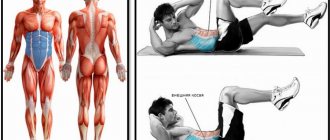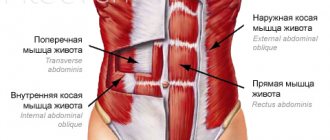As you know, pregnancy is not a disease, but a “special position” of a woman. For this reason, the appearance of a toddler in the womb of the expectant mother does not require a radical change in the usual lifestyle. Of course, we are talking about a normal pregnancy, without the threat of failure. A woman's good physical shape will facilitate not only the process of bearing a baby, but also childbirth. An integral part of a slender, toned body are strong and elastic abdominal muscles. Is it safe to exercise your abdominal muscles during pregnancy? Is it worth giving up training once a new life appears inside a woman and is it possible to pump up your abs in the first weeks of pregnancy?
Will exercising while carrying a child be harmful?
It is not necessary to pump up a pregnant woman’s abs, especially if the girl previously led a passive lifestyle. In this case, it is too late to strengthen the muscles before childbirth, and physical activity can harm the fetus.
But if before conception a woman regularly exercised, then training is not contraindicated.
According to gynecologists, strong abdominal muscles will benefit a pregnant woman. Therefore, they advise regularly training your abs even before conception.
Due to weak abdominal muscles, the expectant mother faces various problems:
- Lower back pain during uterine enlargement.
- Diastasis (divergence) of the rectus muscles in the 3rd trimester of pregnancy.
- Preperitoneal lipoma (hernia in the midline of the abdomen).
- Difficult birth.
- The appearance of stretch marks.
Strong abdominal muscles support an expanding uterus and help avoid stretch marks, as well as lower back pain in later pregnancy. Thanks to trained muscles, efforts during childbirth will be stronger, the fetus will pass through the birth canal faster, and the mother will not be so tired. In addition, it will be easier to regain a thin waist and flat stomach after childbirth.
The benefits of sports activities for the expectant mother
Pregnancy is not a reason to stop playing sports. A trained body will be much easier to cope with bearing a child, the stress of childbirth and recovery in the postpartum period. Naturally, we are not talking about a full-fledged sports load.
Sports activities for pregnant women have their limitations; consultation with a gynecologist is required. Special complexes have been developed that take into account the specifics of the expectant mother’s body. Even if a woman did not exercise before pregnancy, now is the time to start - of course, with the simplest exercises and under the supervision of a doctor.
Optimal abdominal exercises for pregnant women
If the gynecologist has allowed the pregnant woman to pump up her abs, then she can start training. These loads differ from standard ones because they are simpler. But despite this, they will help maintain tone and strengthen muscles.
A set of abdominal exercises for expectant mothers:
- Slowly walk in place or in a circle.
- Then, while walking, begin to raise your knees higher one by one for 40 seconds.
- Now make it more difficult to walk by twisting your shins backwards – 20 seconds.
- Stand up, raise one arm above your head, and put the other on your side, tilt your body to the right and left 5-8 times.
- Place your hands on the back of your head, tilt your body forward – 8 times.
- Lie down on a gymnastic mat, bend your knees, place your hands on the back of your head, but do not clasp them. Smoothly raise your head and shoulders. Carefully monitor your feelings if your health worsens, refuse this exercise.
- Do not change your position; one leg remains on the floor, bent at the knee, and place the other on top. Then try to reach the knee with the elbow of the opposite hand - from 5 to 8 times. Then repeat for the other limbs.
- Stay in the same position and slide your legs straight to feel the tension in your abdominal muscles. Then return to the starting position in the same way.
- Turn over on your side, bend the lower limb and straight the upper limb. Raise your leg so that the distance between it and the floor is 8-10 cm. Using the force of the oblique muscles, pull your thigh up and hold for 5 seconds. Perform 10 repetitions.
- Roll over onto your back, place your hands on the sides of your stomach. Start pushing from your stomach, as if someone is lowering you to the floor, then begin to smoothly lift your upper body, overcoming resistance. When you feel tension in your abdomen, hold for 5-10 seconds, then lie down. Repeat 10 times.
- Stand up, press your back against the wall, feet at a distance of 30-40 cm from it. Bend slightly so your hips lean back slightly as you approach the wall, holding for 5 seconds. Perform 8-10 times.
After week 16, give up movements performed while lying on your back. It is better to train your abs while sitting. To do this, sit on the mat, bend your knees, and smoothly lift them towards your chest. Then repeat with straight limbs. Over time, the number of such elements needs to be reduced, replacing them with breathing exercises.
To strengthen your abdominal muscles, you can sit on a chair, and then gently tilt your body back (but not too much), then get up. In the same position you can raise/lower your straight legs.
Pregnant women should remember that they need to train very carefully, move smoothly, and avoid excessive stress and fatigue. Twisting and lifting of the body should not be performed at full amplitude. Exercise should be stopped immediately when minimal discomfort occurs. To lighten the load, you can use a fitball.
Workouts for pregnant women: do's and don'ts
In previous articles, we have already discussed many issues related to fitness for pregnant women: the most important thing that the instructor should know, and what exercises can and should be performed during pregnancy.
Today we’ll talk about what you should avoid when training in an interesting position, and what you should pay special attention to. Let's look at the most frequently asked questions about different muscle groups and types of training.
TRAINING ABDOMINAL MUSCLES DURING PREGNANCY
As pregnancy progresses, the center of gravity shifts further forward due to the growth of the abdomen, which leads to an increase in lumbar lordosis (bending in the lower back) and the possible appearance of pain in the back. During pregnancy, the abdominal muscles should be strong to help the back muscles maintain a nearly upright body position and minimize discomfort.
This is absolutely correct. But this does not mean that exercises for the rectus abdominis muscle are mandatory during pregnancy in order to make it stronger than it was before. This also does not mean that it is necessary to start “pumping up” the abdominal muscles for those who have not done this before. In reality, if the abdominal muscles were trained before pregnancy, then their reserve of “strength” will be enough for all 9 months for the most comfortable state. If you didn’t have good abs before, then most likely you won’t be able to achieve them during pregnancy.
To understand why this is so, you need to understand what happens to the abdomen during pregnancy from a physiological point of view.
In the first half of pregnancy, the size of the abdominal cavity practically does not increase, because the uterus itself is not yet becoming noticeably larger. During this period, the formation of the child’s body systems occurs without active growth of the fetus in size.
In the second half of pregnancy, the fetus increases significantly in height and weight with each week. The uterus becomes larger, the size of the abdominal cavity increases, and the stomach begins to actively “bulge” forward.
The rectus abdominis muscle must lengthen so as not to interfere with this process. This requires its high elasticity, the degree of which depends on three main factors:
1 – individual (genetic) characteristics
2 – the effect of hormones during pregnancy (relaxin softens connective tissue)
3 – degree of muscle relaxation (the more relaxed it is, the easier it is to stretch)
If muscle elasticity is not enough, the following options are possible:
– the muscles to some extent prevent a further increase in the size of the abdomen and uterus, which, as a result, negatively affects the growth of the fetus. For a woman, this is to some extent a plus: the belly is small and neat, and there is less strain on the back. But this is not the best option for a child’s development.
– the abdomen grows “inward”: the child develops at a normal pace, the uterus grows, but its growth to a greater extent occurs not due to protrusion of the abdomen forward, but due to compression of other organs inside the abdominal cavity. The external effect is the same as in the previous case (small belly), but this does not have the best effect on the functioning of the woman’s internal organs: problems with digestion, breathing, blood circulation, etc. may arise.
– the abdomen is actively increasing in size, but due to insufficient elasticity, the rectus abdominis muscles of the right and left halves of the body begin to diverge to the sides from the linea alba. This phenomenon is called diastasis recti. The connective tissue is stretched, this prolonged tension leads to a decrease in its elasticity, which after childbirth can lead to the fact that the anterior wall of the abdominal cavity becomes less dense and strong. This reduces its protective functions in relation to internal organs. In extreme cases, too much tension can cause the linea alba to rupture.
Ideally, your abdominal muscles should be strong enough to support your ever-growing belly, but flexible enough to avoid the negative effects described above.
To train the abdominal muscles, various modifications of two types of exercises are most often used.
Dynamic option - flexion of the spine in the lumbar and lower thoracic regions;
Static option - different variations of movements/holding the legs suspended while lying on your back.
Let's look at what happens when using these exercises during pregnancy:
– flexion of the spine in the lumbar and lower thoracic regions is possible, but only in the early stages of pregnancy, while the abdomen is not yet clearly defined. At later stages, this becomes more and more difficult (and then almost impossible) purely mechanically - the size of the abdomen simply does not allow bending in these parts of the spine. When pregnant women are offered these exercises, everything is limited to moving the head in the cervical region in an attempt to raise the torso above the floor.
With such a belly, everything is limited to “twitching” in the cervical region and raising the head
– holding the legs (moving the legs) in a suspended position while lying on your back is theoretically possible throughout pregnancy, because these actions do not use flexion of the spine (the abdominal muscles tense to fix the position of the pelvis so that the lower back does not sag), and the growing abdomen does not interfere with movements in the hip and knee joints. The abdominal muscles must exert sufficient strength to hold the pelvis in place. However, as pregnancy progresses and the abdomen grows, the rectus abdominis muscle lengthens, and the longer the muscle, the less force it can exert. It becomes almost impossible for pregnant women to keep their back and pelvis on the floor; an excessive deflection appears in the lower back, which, with a high vertical load on this area, can lead to severe discomfort (at a minimum) or injury to the lumbar region. This exercise is quite difficult to perform even for a non-pregnant woman!
It turns out that in the second half of pregnancy, exercises on the abdominal muscles are either practically impossible (dynamic option) or are fraught with a high risk of negative consequences of their implementation (static option).
In the first half of pregnancy, you can, in principle, train your stomach in the hope that the muscles will have time to become stronger in order to provide greater comfort in later stages. But there probably won’t be enough time for this. But muscle tone may well become higher if you force the load too much - for example, “pump your stomach” every day in a large volume. Increased tone prevents normal muscle lengthening, which is necessary at this moment. As a result, the diastasis described above occurs (this is quite often observed in athletes with six-pack abdominals). Of course, there is always a risk of diastasis recti, but with intense training it increases. This is not to say that abdominal exercises are strictly prohibited during pregnancy. But when planning your workouts, you need to evaluate the potential benefits of training your abdominal muscles and weigh them against the possible risks.
Ideal for a woman: training the abdominal muscles in combination with developing the skill of correct posture before pregnancy, which will help you feel more comfortable throughout the entire 9 months. And during pregnancy, it is better to focus on doing other exercises.
If the ideal option did not work out, you did not train your stomach before pregnancy, then instead of ambiguous crunches and other abdominal exercises, it is better to focus on posture and exercises to relax the back muscles.
TRAINING THE BACK MUSCLES (SPINAL EXTENSORS) DURING PREGNANCY
The main function of the spinal extensor muscles is to hold the torso in an upright position and maintain balance through this. These muscles are constantly used in everyday life - almost always when we are not lying down. During pregnancy, the load on the extensor muscles increases due to natural changes. As pregnancy progresses, the center of gravity shifts forward due to the growth of the abdomen, and the lower back sags more and more. At the same time, the size and weight of the breasts increase, and this leads to the dropping of the shoulders forward and the appearance of a slouch in the upper body. As a result, changes in the original anatomical position occur in two parts of the spine at once: an increase in lumbar lordosis and thoracic kyphosis. This simultaneous “overcurvature” can cause discomfort and pain in the back. The task of the spinal extensor muscles is to compensate for pregnancy-related changes in posture and help avoid pain. To do this, the muscles must be strong enough.
The common logic of many fitness instructors: mandatory exercises to strengthen the spinal extensor muscles (hyperextension) in order to maintain their strength or have time to make them strong during pregnancy.
We don't recommend doing this. Let's explain why.
If a woman has strong enough spinal extensor muscles because she trained before pregnancy, then these muscles will be able to counteract excessive curvature of the spine and poor posture, because will be able to hold the body in an even vertical position. At the same time, unpleasant sensations will manifest themselves to a lesser extent. They may not even exist at all.
However, additional exercises on the extensor muscles will be unnecessary. After all, during pregnancy these muscles will constantly tense in everyday life, receiving a natural additional load that they previously received during training.
If a woman did not exercise before pregnancy, then for her muscles, daily additional efforts will be a greater load than before pregnancy, i.e., in fact, training. When muscles are constantly tired, it is not advisable to additionally load them. Rather, they need recovery from daily unusual stress.
In both cases, we would suggest focusing on relaxing and stretching the ever-tiring spinal erector muscles.
Training the extensor muscles can be important at the beginning of pregnancy, while the daily load is low - before the growing belly and breasts begin to change their posture. But even during this period, in our opinion, it is better to focus on exercises aimed more at developing or maintaining correct posture, rather than on strength exercises on the back muscles. When performing special exercises on posture, we in any case use the extensor muscles, which can be a sufficient load for them. And besides this, we form the skill of maintaining an even vertical body position, which is so necessary at this time.
Several recommended exercises for pregnant women - for posture and stretching
SHOCK LOADING, STRENGTH EXERCISES, AQUA AEROBICS DURING PREGNANCY
To understand in what form and why it is worth offering or not offering such a load and these types of exercises, you must first consider the physiological effect of the hormone relaxin on the body of a pregnant woman.
The effect of relaxin on the body as a whole and on the musculoskeletal system
During pregnancy, the hormone relaxin begins to be produced. Under its action, the connective tissue softens, becomes more pliable (extensible) and less rigid (durable). In this way, nature prepares a woman’s body for pregnancy and childbirth.
More pliable connective tissue is needed so that during pregnancy the uterus can increase in size for the normal growth of the child, so that the skin can easily stretch in the right places without damage.
During childbirth, the softened connective tissue in the cervical area ensures easier opening, the high extensibility of the perineal area helps prevent ruptures, and the softened pubic symphysis and iliosacral joint help the pelvic bones “move apart” as the child passes through the birth canal to avoid injury to the mother. , and so does the baby.
But there is also a downside to the effects of the hormone relaxin: the musculoskeletal system becomes more vulnerable in terms of resistance to stress. Indeed, due to the softening of connective tissue, the strength of the ligaments and the stability of the joints are reduced. This can lead to discomfort and sometimes quite severe pain even with normal movements in everyday life. Naturally, with additional physical activity, the sensations of discomfort and pain will be significantly higher, as will the risk of injury.
For this reason, you should be more careful when choosing certain types of loads and exercises.
Several recommended exercises for pregnant women - for posture and relaxation
High impact load
The shock load that occurs when performing exercises in a standing position can be traumatic for the joints of the lower extremities and spine. This risk is especially evident under high impact loads, which involve the use of jumping and running actions. The degree of possible negative impact depends on the following factors: the weight of the person, the shock-absorbing properties of the joints, the position of the spine, and landing technique. The greater the weight, the lower the strength of the joints and ligaments, the less even (vertical) the position of the spine, the higher the impact load will be.
In order to avoid injury, you must have the skill of safely performing such movements (the skill of correct landing). If a woman knows how to run and jump well, then using these exercises during pregnancy is acceptable, of course within reasonable limits.
But we must remember that, regardless of physical capabilities and motor skills, changes occur in the body during pregnancy that lead to an increase in shock load and a decrease in the ability to withstand it. Your own weight constantly and very significantly (especially in the second half of pregnancy) increases. This in itself is an additional load on the joints of the legs and spine. Naturally, the impact load during all movements increases (even if they are performed correctly). Joints and ligaments, becoming softer under the influence of relaxin and less strong, cope worse with increasing load, their shock-absorbing properties decrease. A change in the position of the spine due to an increase in lumbar lordosis leads to deterioration of shock absorption in this area. All of these changes increase the risk of injury. Therefore, as pregnancy progresses, it is worth minimizing the amount of running and jumping, if previously they were used in training practice. And for those who have not previously run or jumped or have done it incorrectly (unsafely), it is better to abandon these types of exercises altogether.
It is advisable to limit a high impact load (or even completely eliminate it) also because due to an increase in the abdomen and a shift in the center of gravity, the risk of loss of balance increases.
Power load
Strength exercises and strength loads should also be selected taking into account the physiological changes that occur. There is no need to exclude strength training, but the methodology must be adjusted.
Load intensity
Those for whom power loads are familiar, who trained “before”, need to gradually reduce the intensity of the loads. Indeed, despite the fact that the muscles themselves are quite capable of withstanding the usual level of load, and a woman may feel ready to continue training with the same intensity, it should be remembered that the condition of the joints and ligaments changes fundamentally. Due to the effects of relaxin, they are not ready to continue to safely resist the load they previously handled.
And for those who didn't exercise before pregnancy, it can be even more dangerous. Therefore, power loads for them should be selected especially carefully. It is better to limit yourself to minimal impact so as not to lead to overwork and injury.
Optional equipment
Any additional equipment may be an additional power load. In addition, the use of various objects in training requires the ability to handle them in a way that is safe for humans.
The equipment can be used (remember the difference between the words “can” and “need”), but should not be abused. It’s better to think about it in advance - is it really so necessary that you can’t do without it?
Additional equipment (dumbbells, body bars, barbells, rubber shock absorbers, etc.) is often used to increase the degree of load. Considering what we wrote above about intensity, it’s worth thinking about before using it. It is likely that you can do without equipment using only your own body weight. Especially with those who did not engage in strength training before pregnancy. Often trainers do not realize that in the second half of pregnancy a woman already carries an ever-increasing weight. Sometimes greater than the weight of the bar from a barbell, for example, or a body bar. Therefore, the weight of the additional equipment, together with her own increased weight, can become an excessive load, especially in the initial standing positions when performing exercises on the muscles of the lower extremities.
If you have been involved in strength training before, if you have developed the skill of working with equipment, then there is no reason to give it up completely. You just need to gradually reduce the working weight and reduce the complexity of the exercises.
If a woman has never trained with equipment and does not know how to use it, then she must first be taught how to use it. However, you should not get carried away and spend a lot of time on something that is not a task of primary importance. Moreover, pregnancy is not the best time to learn new skills. Moreover, any. The head of pregnant women works completely differently; nature has made sure that most of the body's resources (including the brain) are spent only on the successful gestation of the fetus. That's why pregnant women become so distracted.
The only thing that may be worth focusing on is exercises with additional weight for the arm muscles. A dumbbell of 1-1.5 kg for isolated training of the biceps brachii, deltoid muscle, and pectoral muscles may well be useful, since the expectant mother after childbirth must be prepared to carry more weight in her hands.
Starting points
The longer the pregnancy, the greater your own weight and the higher the load on the joints of the legs. It is increasing every day. It becomes increasingly difficult to perform exercises while standing. Therefore, during training you should gradually replace them with exercises in a position on the floor. This is especially true for untrained women whose joints are not accustomed to high loads.
In addition, during pregnancy, blood often stagnates in the lower part of the body. This occurs in particular due to prolonged immobile standing. As a result, swelling, varicose veins, and hemorrhoids may occur. Therefore, we need exercises that improve blood circulation in the lower extremities: normal walking, rolling the feet from heels to toes and back, various (including circular) foot movements. Many of these exercises can be performed not only standing, but also in any other position (sitting, lying down), and do not require additional equipment. Such movements should be performed not only in class, they should be recommended in any situations where you have to stand or sit motionless for a long time: at work, in the car, on public transport, in line or in front of the TV.
The initial position lying on the stomach, for obvious reasons, must be eliminated as soon as the stomach begins to increase in size.
The starting position lying on your back is often prohibited from being used in classes (most instructors who come to the seminar are absolutely sure of the correctness of this prohibition). There is a widespread opinion that this provision should be excluded from training, because there is a risk of compression of the inferior vena cava, which leads to dizziness, lightheadedness and even loss of consciousness.
Yes, it can happen. But not with everyone, and not in every case - many women do not even suspect such a problem, they rest and sleep throughout their pregnancy, lying on their backs, and nothing bad happens. However: forewarned is forearmed.
To do this, instead of excluding the supine position from the training process, without telling anything about possible unpleasant and even dangerous consequences, it is better to do differently. Ask if the woman has already encountered the situation described above in everyday life or in other activities. Explain why this happened or might happen in the future. Teach how to behave when the first symptoms occur: stop doing the exercise, roll over onto your left side (to reduce pressure on the inferior vena cava, since it runs to the right of the spine), perhaps even sit down (but not sharply). Suggest doing the exercise while lying on your back and carefully monitor how you feel. If everything is in order, then there is no reason to exclude such exercises. They should be abandoned only if the symptoms described above appear.
In the future, it is necessary to advise a woman in everyday life to pay attention to the slightest unpleasant sensations when she lies on her back. If discomfort appears, you will have to rest and sleep so that your torso is in an elevated position.
Using this tactic, we not only retain the opportunity to use a fairly wide range of exercises, but also, most importantly, help a woman feel as confident and comfortable as possible outside of our classes.
Aqua aerobics
There is a general opinion that water aerobics is recommended for absolutely all pregnant women, because it is the best and safest form of physical activity for them.
What is true about this statement? Indeed, being in the water feels very pleasant, because... your own weight “reduces” compared to the actual weight of the body “on land” due to the buoyant action of water. At the same time, the vertical (shock) load is reduced, the joints of the lower extremities and spine are “unloaded”. Additionally, there is a natural micro-massage of the skin, etc.
But it's one thing to just be in the water. It’s another thing entirely to move. If you compare the resistance force of the air and water environments when performing movements, you will see a clear difference. When you move on land in different directions (to the sides, back and forth), air resistance is practically not felt, because it's too small. If the same actions are performed in water, then they will be much more difficult to perform, because... The water resistance force is much higher. Try simply raising your arms forward to the horizontal on land and in water and compare which is heavier.
Therefore, any activity in water can be even more traumatic for joints and ligaments than on land. You need to remember this when doing swimming or water aerobics. The principle is the same: if you did this before pregnancy, continue, reducing the speed of swimming, reducing the amplitude and pace of exercises during water aerobics, doing everything very smoothly and controlling your movements.
If you haven’t done it, but really want to start, be extremely careful. Follow all the nuances, control the amplitude and speed of the exercises, since “pulling” a softened joint in the water is very simple (especially when using additional equipment: a swimming paddle on the palm will greatly increase the load on the elbow and shoulder joints).
HOW TO DETERMINE WHICH EXERCISE CAN AND WHICH NOT BE OFFERED TO PREGNANT WOMEN
We have considered only some exercise options; it is impossible to sort everything out. But if you need to decide for yourself what to offer or not offer during training with pregnant women, then we recommend using the logic below.
Don’t ask the question: “what not to do for pregnant women.” Consider any exercise, first of all, from the standpoint of expediency, answering two questions first.
First: can this exercise be performed by a pregnant woman? In most cases, this question can be answered positively, provided that the pregnancy is normal and there are no obvious pathologies (pathologies can only be identified by a doctor; a fitness trainer does not have the right to make conclusions about the course of pregnancy). And also when it comes to what a woman did before pregnancy, and what is habitual and natural for her.
The second, much more difficult question: how much does a pregnant woman need this exercise? How useful it will be, given her position and individual condition. This question is inextricably linked with the goals and objectives of training during pregnancy.
For example: is it possible to offer a woman a high-coordination load during pregnancy? In principle, it is possible. There are no clear categorical contraindications. But is it necessary?.. Especially considering that this load is harder for a woman due to changes in the functioning of the nervous system. In addition, due to a shift in the center of gravity when performing complex exercises, there is a greater risk of losing balance, tripping and harming yourself. If you choose between coordination and strength training, then it would be more advisable to offer, for example, strength exercises for the arm muscles. Strong arms will be very useful after childbirth. It is better to leave the development of coordination capabilities for later.
Another important filter for selecting or excluding certain exercises: individual condition and whether the woman exercised before pregnancy. What would be completely normal for someone who trained before pregnancy may be unacceptable and/or simply impossible for another pregnant woman. For example, if a woman is a master of sports in alpine skiing, then skiing is as common for her as walking for ordinary people. Therefore, it would be illogical to prohibit her from this activity. Moreover, the natural instinct of caring for the child will most likely protect her from too extreme skating. And ordinary human logic allows one to gradually abandon this hobby as pregnancy progresses. However, those who are not professionals in this matter should not “get up” to ski. The experience can be disastrous...
In general, decisions on such issues should be made based on an understanding of the anatomy and physiology of pregnancy, as well as knowledge of training theory in general. If you hear somewhere a categorical “this cannot/can/should be done”, always analyze this statement, trying to get an answer to the question “why”, based on the knowledge of these sciences.
We study in detail the physiology of pregnancy and training methods for pregnant women at the seminar Fitness training methods for pregnant women (4 days).
Creation date: February 13, 2017
Contraindications
It is prohibited for expectant mothers to train their abs in the following cases:
- Threat of spontaneous abortion.
- Hypertonicity of the uterus.
- The appearance of reddish or brownish discharge.
- Pain in the lower abdomen.
- Toxicosis, which is accompanied by frequent vomiting and exhaustion.
- Presence of complications: incorrect location of the placenta, hypertension, excess amniotic fluid, etc.
It is better to stop exercising if the following symptoms appear:
- Intense headache.
- Increased heart rate.
- Dyspnea.
- There is a tugging in the lower abdomen, or there is pain reminiscent of contractions.
Important! In such cases, training should be stopped, even if the doctor has approved physical activity. In addition, it is worth visiting a doctor who will find out the reason for the appearance of suspicious signs.
You can train your abs only if the process does not cause discomfort and gives pleasure to the expectant mother.
Who and why should not pump abs during pregnancy?
The abdominal muscles are located in close proximity to the uterus, and it is in it that a woman’s baby grows and develops. For this reason, exercise is prohibited if:
- the woman has even the slightest signs of a threat of miscarriage (pain, increased tone of the uterus, spotting or spotting);
- there is severe toxicosis, accompanied by general weakness, frequent vomiting, and decreased blood pressure;
- pregnancy complications arose - marginal or complete placenta previa, high blood pressure, polyhydramnios.
Even if a woman has no prohibitions or restrictions regarding physical activity, exercise should be stopped in the following cases:
- A severe headache appeared.
- The heart rate increased, shortness of breath appeared, and a feeling of lack of air appeared.
- Discomfort or pain in the abdomen (intense or nagging) appears.
The main danger of physical activity during pregnancy lies in the risk of spontaneous termination of pregnancy earlier than expected. The expectant mother should carefully listen to the doctor’s recommendations and her feelings. If any discomfort or deterioration in well-being occurs, exercise should be stopped.
Experts' opinions
Qualified gynecologists advise women to exercise only after the approval of their personal physician. If there are no contraindications, then a woman can perform lighter versions of standard abdominal movements. At the same time, you should constantly monitor your condition. If you experience discomfort in the lower abdomen, headaches, shortness of breath, increased heart rate, or simply fatigue, you should stop training and consult a doctor. If there is no discomfort, and the woman has previously exercised regularly, then exercises for the abdominal muscles will only bring benefits.
Olga Panfilova, doctor
An obstetrician-gynecologist at the Women's Health Center claims that it is possible to train the abdominal muscles in the 1st trimester, but in the absence of contraindications. Starting from the 2nd trimester, you should stop exercising while lying on your back. This is due to the fact that the enlarged uterus compresses the vessels through which blood flows to the heart and brain. Then the likelihood of developing inferior vena cava syndrome increases, which is manifested by fainting.
However, light physical activity during pregnancy is very beneficial. After regular training, blood flow increases, then the likelihood of stagnation in the vessels of the legs decreases.
In any case, you should consult your personal physician before exercising. If there are no contraindications, the specialist will help the expectant mother choose the safest loads.
Olga Yakubovskaya, trainer
The yoga instructor believes that during pregnancy you should even exercise, paying special attention to your abdominal muscles. After all, a strong muscle corset will make pregnancy easier and guarantee a successful birth. However, using standard elements that are usually performed to pump up the press is prohibited!
Effective and simple yoga asanas will help strengthen your abdominal muscles. They definitely won’t harm the baby or mother. Belly dancing will allow the expectant mother to increase her muscle tone. During smooth movements of the hips, swaying, and circles, almost all abdominal muscles are involved in the work. However, before training, a woman should consult with her personal doctor so as not to expose the unborn child and herself to danger.
Tamara Yakobovna, doctor
A qualified obstetrician-gynecologist highlighted the basic rules for abdominal training for pregnant women:
- Modify the exercises depending on the period: the longer it is, the lower the load on the abdominal muscles should be; you should help yourself with your arms and legs.
- Monitor your feelings. If you experience discomfort during exercise, stop immediately, rest, and visit a doctor as soon as possible.
- If you haven't exercised before pregnancy, skip ab workouts or exercise under the supervision of a qualified pregnancy fitness instructor.
And, of course, before conducting classes, consult with your personal gynecologist.
When is the best time to skip classes?
If you have health difficulties, tell your coach about it, and additionally clarify your question regarding sports with your doctor. As soon as you visit a gynecologist, be sure to ask about exercise levels if you prefer to spend time in the gym often. The doctor will tell you whether it is possible to pump up your abs during pregnancy in the first trimester. Be sure to check with him what will happen if you pump up your abs during pregnancy.
But there are dangerous phases of pregnancy, during which it is better to interrupt even special training for expectant mothers. Dangerous ones include:
· from 2 and 3 weeks;
· from 12 and 13 weeks;
· from 20 to 24 weeks;
· 28th week.
During these weeks, it is better to exclude not only sports, but also other emotional stress.
If you have general weakness or headache, you should replace the workout with exercise at home. Also remember that such unpleasant symptoms during pregnancy are not the norm, so do not go to the gym, but to see a doctor.
If you feel pain in the first trimester and cannot do without medication, then lie on the couch and cancel all plans.
Main conclusions
An expectant mother can train her abs, but under the following conditions:
- After an examination, the doctor approved the initiative of the expectant mother.
- There are no contraindications (toxicosis, threat of miscarriage, hypertension, placenta previa, etc.).
- The pregnant woman feels well, and training brings her pleasure.
- The complex consists of lightweight exercises to improve the tone of the abdominal muscles.
- The load corresponds to the period of pregnancy.
- A woman has not done press exercises on her back since the 2nd trimester.
- The expectant mother regularly exercised even before conception.
In other cases, it is better to refuse training the abdominal muscles in order to protect the child and yourself.
How to pump up your abs when planning a pregnancy
Many women planning the appearance of a toddler are concerned about the issue of stress on the abdominal muscles. Moderate physical activity will not only strengthen the abdominal muscles, but also improve blood circulation in the pelvis. Good blood circulation creates favorable conditions for endometrial growth, as well as normal ovulation. These factors create excellent conditions for pregnancy. The only thing you should be careful with is abdominal exercises in the second phase of the menstrual cycle. This does not mean that a woman needs to completely give up training. Classes should be continued, but carried out at a more relaxed pace, without overload. A healthy and prepared body will be an excellent home for your baby for 9 months.
Abdominal pumping at different stages of pregnancy
When you finally manage to conceive a long-awaited child, you need to make every effort to save it. During the first trimester, the embryo is not yet completely securely attached, and therefore intense exercise can lead to miscarriage. A woman should observe all the sensations that accompany her throughout the day. In case of any physical strain, you need to lie down and rest. During this period, it is better to replace the usual training of various muscle groups, including the abdomen, with spending time in the fresh air, yoga and gymnastics designed for pregnant women. Only a highly qualified trainer will be able to create a training program that will not harm the fetus and the expectant mother.
In the second trimester, physical activity is quite acceptable, but in a gentle manner. You need to forget about the classic exercises for perfect abs. They are absolutely not suitable, especially those performed in a supine position. Closer to childbirth, short-term exercises are recommended in order to prepare the body for the upcoming event. It is important that at the first painful discomfort, any loads should be stopped.
How to do exercises correctly?
There is a set of exercises designed specifically for expectant mothers. It helps maintain the abdominal muscles in the desired shape without overloading them. This complex can be performed in the early stages up to 4 months. It includes the following simple exercises:
- Walking in place at a moderate pace. You should march for about 2-3 minutes.
- Marching in place with high knees. The duration of the exercise is up to 45 seconds.
- Walking backwards. It should be performed no longer than 20 seconds.
- Smooth tilts to the side. To perform the exercises, you need to place one hand on your belt and raise the other up. Bend towards the raised arm.
- Raising the body up from a lying position on the floor. Legs should be bent. You can perform this no more than 20 times. You need to raise your body not to knee level, but only slightly above the floor.
- Flexion and extension of the legs from a lying position. To perform the exercise, your arms should lie perpendicular to your body.
- Raising the body from a sitting position on a chair. To do this, you need to sit on a chair without a back, rest your feet on the floor, and lean your torso back until it becomes difficult to maintain your balance. From this position return to the starting position. Repeat 15-20 times.
After 16 weeks, it is recommended to completely switch to gymnastics in a sitting position. The best type of abdominal exercise is raising and lowering your legs. Any exercises should be performed slowly, without applying much effort. Their main task is not to pump up muscles, but only to maintain their shape and prevent them from atrophying.
Special exercises for pregnant women on a fitball have a good effect. It’s even better to do breathing exercises: it’s good for the abs, safe for the baby, and prepares for childbirth.











